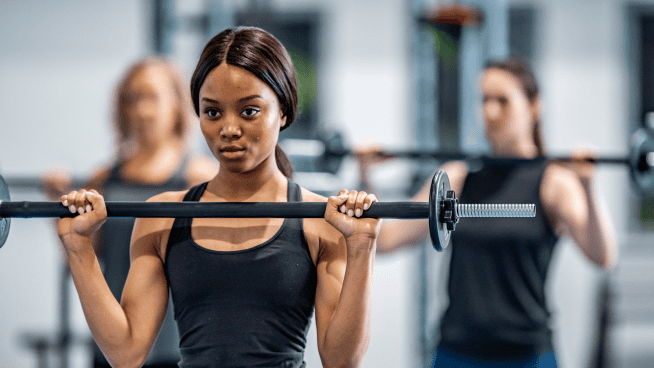5 Reasons Athletes Should Train With Olympic Lifts
Most athletes have an exercise routine tailored to their particular strengths. Cross country runners spend a lot of time working on stamina and speed, and their workout routines involve primarily going for runs. Basketball players focus on workouts that target their legs, coordination and reflex times. Ice skaters need to focus on balance, strength in their legs and a long and lean physique. Although not every athlete is trying to be a bodybuilder, all of them can benefit from adding Olympic lifting to their repertoire of exercises.
RELATED: The 5 Most Common Olympic Lifting Mistakes And How to Fix Them
Weightlifting is often seen as the domain of bodybuilders who beef up, not performance athletes. And although resistance development may be on everyone’s list of skills, there’s nothing quite like Olympic lifting for athletes trying to improve their performance. Everyone can benefit from a good session of Olympic lifting.
1. Increases your force capability
Olympic weightlifting’s greatest benefit is its ability to help an athlete develop greater force capabilities. Strength training in general is ideal for developing force, which propels the most basic of an athlete’s capabilities, but nothing develops force across muscle groups as effectively as the Snatch. This exercise involves grabbing the bar and bringing it above your head in one clean movement, then rising back up and standing tall before dropping it. It’s intense and it helps build massive strength, as well as coordination and balance. Other Olympic lifts produce similar results.
RELATED: How Olympic Lifts Increase Speed
2. Increases running start force
For runners, whether they focus on cross-country or sprinting, starting speed can be a critical component of their success on the field. Similar things can be said for speed skaters and other athletes whose strength in their legs affects their performance. Luckily, weightlifting does wonders for your starting strength.
In a 2004 study, Olympic weightlifters improved their starting speed more than power weightlifters; and in multiple incidents, Olympic weightlifters have shown that they can either keep up with or surge ahead of sprinters in the opening phase of a race from sheer starting force alone. These opening seconds are crucial to sprinters in particular, and the strength you develop in your legs through Olympic lifting can be invaluable in a race.
3. Makes you more flexible
The classic method of improving flexibility is to incorporate stretching into an exercise routine. However, studies have found that weightlifting is even more effective than stretching for improving flexibility. This is because the range of motion required in lifting is great enough to do the stretching for you, and the muscle development does not in any way inhibit flexibility. A classic Olympic lift, like the Snatch, requires you to jerk a heavy bar up and down, bending down for full Squats and otherwise pulling your muscles in multiple directions. After completing a move, you feel a pulling sensation in all your muscles—that’s the flexibility development the activity offers. It’s particularly good for your knees, because bending and squatting builds up your thigh and calf muscles.
RELATED: A Beginner Olympic Lifting Program
4. Improves your vertical jump
This is a benefit basketball players in particular can gain from Olympic weightlifting. They can promote massive improvements in their jumping capability, bringing them higher to the basket and helping the score more points. This is a result of the flexibility and force development offered by Olympic lifting. Studies show, like in running, that Olympic lifters improved their jump more than power lifters, and their jump and speed improved in significant ways. The study also found that Olympic lifters benefitted more broadly than power lifters. The explosive power developed by Olympic weightlifting makes a significant difference in the height and strength of your vertical jump.
5. Burns fat and builds muscle
One of the most misunderstood aspects of bodybuilding is what it does to your physical appearance. Women worry about bulking up, men worry about losing flexibility and everyone worries about becoming a lumbering bodybuilder.
Although it’s true that Olympic weightlifting can help build muscle and burn fat, it doesn’t have to be a significant amount. Your training can incorporate only the muscle development you need and no more; bodybuilders do not accidentally achieve their size through a few extra lifts each session.
Olympic lifting is a valuable tool for all athletes, although it may not look it on the surface. It is so beneficial for building up force capabilities that it can be integrated into any athlete’s regimen for improved performance in the gym and on the field.
Photo Credit: Tara Moore/Stone/Getty Images
[cf]skyword_tracking_tag[/cf]RECOMMENDED FOR YOU
MOST POPULAR
5 Reasons Athletes Should Train With Olympic Lifts
Most athletes have an exercise routine tailored to their particular strengths. Cross country runners spend a lot of time working on stamina and speed, and their workout routines involve primarily going for runs. Basketball players focus on workouts that target their legs, coordination and reflex times. Ice skaters need to focus on balance, strength in their legs and a long and lean physique. Although not every athlete is trying to be a bodybuilder, all of them can benefit from adding Olympic lifting to their repertoire of exercises.
RELATED: The 5 Most Common Olympic Lifting Mistakes And How to Fix Them
Weightlifting is often seen as the domain of bodybuilders who beef up, not performance athletes. And although resistance development may be on everyone’s list of skills, there’s nothing quite like Olympic lifting for athletes trying to improve their performance. Everyone can benefit from a good session of Olympic lifting.
1. Increases your force capability
Olympic weightlifting’s greatest benefit is its ability to help an athlete develop greater force capabilities. Strength training in general is ideal for developing force, which propels the most basic of an athlete’s capabilities, but nothing develops force across muscle groups as effectively as the Snatch. This exercise involves grabbing the bar and bringing it above your head in one clean movement, then rising back up and standing tall before dropping it. It’s intense and it helps build massive strength, as well as coordination and balance. Other Olympic lifts produce similar results.
RELATED: How Olympic Lifts Increase Speed
2. Increases running start force
For runners, whether they focus on cross-country or sprinting, starting speed can be a critical component of their success on the field. Similar things can be said for speed skaters and other athletes whose strength in their legs affects their performance. Luckily, weightlifting does wonders for your starting strength.
In a 2004 study, Olympic weightlifters improved their starting speed more than power weightlifters; and in multiple incidents, Olympic weightlifters have shown that they can either keep up with or surge ahead of sprinters in the opening phase of a race from sheer starting force alone. These opening seconds are crucial to sprinters in particular, and the strength you develop in your legs through Olympic lifting can be invaluable in a race.
3. Makes you more flexible
The classic method of improving flexibility is to incorporate stretching into an exercise routine. However, studies have found that weightlifting is even more effective than stretching for improving flexibility. This is because the range of motion required in lifting is great enough to do the stretching for you, and the muscle development does not in any way inhibit flexibility. A classic Olympic lift, like the Snatch, requires you to jerk a heavy bar up and down, bending down for full Squats and otherwise pulling your muscles in multiple directions. After completing a move, you feel a pulling sensation in all your muscles—that’s the flexibility development the activity offers. It’s particularly good for your knees, because bending and squatting builds up your thigh and calf muscles.
RELATED: A Beginner Olympic Lifting Program
4. Improves your vertical jump
This is a benefit basketball players in particular can gain from Olympic weightlifting. They can promote massive improvements in their jumping capability, bringing them higher to the basket and helping the score more points. This is a result of the flexibility and force development offered by Olympic lifting. Studies show, like in running, that Olympic lifters improved their jump more than power lifters, and their jump and speed improved in significant ways. The study also found that Olympic lifters benefitted more broadly than power lifters. The explosive power developed by Olympic weightlifting makes a significant difference in the height and strength of your vertical jump.
5. Burns fat and builds muscle
One of the most misunderstood aspects of bodybuilding is what it does to your physical appearance. Women worry about bulking up, men worry about losing flexibility and everyone worries about becoming a lumbering bodybuilder.
Although it’s true that Olympic weightlifting can help build muscle and burn fat, it doesn’t have to be a significant amount. Your training can incorporate only the muscle development you need and no more; bodybuilders do not accidentally achieve their size through a few extra lifts each session.
Olympic lifting is a valuable tool for all athletes, although it may not look it on the surface. It is so beneficial for building up force capabilities that it can be integrated into any athlete’s regimen for improved performance in the gym and on the field.
Photo Credit: Tara Moore/Stone/Getty Images










